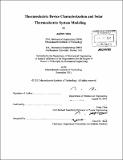Thermoelectric device characterization and solar thermoelectric system modeling
Author(s)
Muto, Andrew (Andrew Jerome)
DownloadFull printable version (25.76Mb)
Alternative title
Solar thermoelectric system modeling
Other Contributors
Massachusetts Institute of Technology. Dept. of Mechanical Engineering.
Advisor
Gang Chen.
Terms of use
Metadata
Show full item recordAbstract
Recent years have witnessed a trend of rising electricity costs and an emphasis on energy efficiency. Thermoelectric (TE) devices can be used either as heat pumps for localized environmental control or heat engines to convert heat into electricity. Thermoelectrics are appealing because they have no moving parts, are highly reliable, have high power densities, and are scalable in size. They can be used to improve the overall efficiency of many systems including vehicle waste heat, solar thermal, HVAC, industrial waste heat, and remote power for sensor applications. For thermoelectric generators to be successful, research progress at the device level must be made to validate materials and to guide system design. The focus of this thesis is thermoelectric device testing and system modeling. A novel device testing method is developed between room temperature range and 230°C. The experimental technique is capable of directly measuring an energy balance over a single leg, with a large temperature of 2-160°C. The technique measures all three TE properties of a single leg, in the same direction, with significantly less uncertainty than other methods. The measurements include the effects of temperature dependent properties, side wall radiation loss, and contact resistance. The power and efficiency were directly measured and are within 0.4 % and 2 % of the values calculated from the property measurements. The device property measurement was extended to higher temperatures up to 600°C. The experimental system uses an inline unicouple orientation to minimize radiation losses and thermal stress. Two major experimental challenges were the construction of a high temperature calibrated heater and a thermocouple attachment technique. We investigated skutterudite materials which are of interest to many research groups due to their high thermoelectric figure-of-merit (ZT), and good thermomechanical properties. Unlike room temperature Bi2Te 3 devices, skutterudite module construction techniques are not well established and were a major challenge in this work. Skutterudite device samples were fabricated by a direct bonding method in which a rigid electrode is sintered directly to the TE powder during press. Compatible electrode materials were identified and evaluated based on thermal stress, parasitic electrical/thermal resistance, chemical stability and ease of prototype fabrication. The final electrodes solutions were Co2 Si with the P-type and CoSi2 with the N-type. The direct hot press process was modified into what we call a hybrid hot press to produce device samples with strong bonds and no cracks. Preliminary accelerated aging tests were conducted to evaluate the long term chemical stability of the TE-electrode contacts. We demonstrated ZTff = 0.74 for the N-type between 52°C and 595°C corresponding to 11.7% conversion efficiency and Zlff = 0.51 for the P-type between 77°C and 600°C corresponding to 8.5% efficiency. The maximum efficiency of the NP unicouple was measured to be 9.1% at ~550°C. The effective ZT and efficiency measurement includes electrical contact resistance, and parasitic thermal/electrical resistance in the electrodes, and heat losses at the sides of the legs. Thus we have included all the parasitic loss effects that are present in a real unicouple. The efficiency values measured in this work are among the highest recorded for a skutterudite unicouple. The TE-electrode combinations meet all the criteria for device testing and offer a practical, manufacturable solution for module construction. Solar thermal power generation is fast becoming cost competitive for utility scale electricity with 380 MW electric currently installed. Parabolic trough concentrators have proven economical and reliable but their efficiency is limited by the maximum temperature of the heated fluid. We explored the idea of a solar thermoelectric topping cycle (STET) in which a thermoelectric generator (TEG) is added at high temperature to increase the overall efficiency of the solar Rankine cycle. In this design the perimeter of the receiver tube is covered with thermoelectrics so that the absorber temperature is raised and the energy rejected from the TEG is used to heat the fluid at its originally specified temperature. A heat transfer analysis was carried out to determine the overall system efficiency. A parametric study was performed to identity design constraints and put bounds on the total system efficiency. The system performance was simulated for all conceivable concentrations and fluid temperatures of a solar thermal trough. As the absorber temperature increases more power is generated by the TEG but is offset by a rapidly decreasing absorber efficiency which results in only a marginal increase in net power. It was concluded that for the proposed STET to increase the system efficiency of a state of the art trough system by 10% requires a ZI =3 TEG, which is well beyond the state-of-the-art thermoelectric materials.
Description
Thesis (Ph. D.)--Massachusetts Institute of Technology, Dept. of Mechanical Engineering, 2011. Cataloged from PDF version of thesis. Includes bibliographical references (p. 152-155).
Date issued
2011Department
Massachusetts Institute of Technology. Department of Mechanical EngineeringPublisher
Massachusetts Institute of Technology
Keywords
Mechanical Engineering.